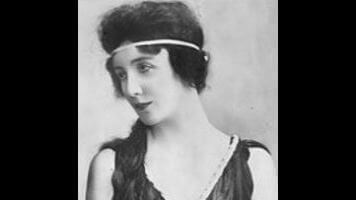When Audrey Munson was 5 years old, a gypsy fortune-teller predicted that one day she would be famous. The fortune-teller also predicted that her happiness would be short-lived and “turn to ashes in [her] mouth.” As it turns out for Munson, model, actress, and early 1900s celebrity, the soothsayer was right.
James Bone’s The Curse Of Beauty explores, for the first time, the life, achievements, and ultimate demise of what he calls “America’s first supermodel.” After moving to New York City with her single mother as a teenager in the early 1900s, Munson found work as a chorus girl and was eventually spotted by an artist who asked to photograph her. This fateful encounter spiraled Munson into the art world of the Big Apple, where she found herself posing, often nude, for artists who would sculpt her for monuments that went up throughout the city. Munson became the model for works including the winged “Descending Night” at the Metropolitan Museum Of Art, “Columbia Triumphant” in Columbus Circle, and “Civic Fame,” the robed and wreathed goddess standing atop the Manhattan Municipal Building, among many others.
Praised as one of the most beautiful women in the world, Munson’s modeling fame led her to the silent screen, where she starred in early motion pictures and earned the somewhat dubious distinction of being the first “star” to perform nude in film. But, true to the gypsy fortune, Munson’s life took a downturn.
She became peripherally involved in the murder trial for a doctor who had killed his wife in cold blood, allegedly after falling in love with Munson. After the doctor committed suicide in jail, Munson, unfairly associated with the crime and convinced that she was being blackballed by the industry, saw movie roles dry up. She found herself waiting tables and selling kitchenware door to door to earn enough money to live.
Eventually, reclusive and with reportedly deteriorating mental health, Munson was committed by her own mother to St. Lawrence State Hospital For The Insane in upstate New York, where she lived for 65 years until her death in 1996 at 104 years old.
The Curse Of Beauty tells Munson’s story in full with the benefit of newly released documents and information shared by the family. The author explores tangents through the New York City art world of the 1900s and the nascent motion picture industry, setting Munson’s work into important context. Early feminism, turn-of-the-century high society, sexism, censorship, and misogyny are necessarily explored. Unfortunately, these more important societal issues too often take back seat to the factual description of Munson’s life, and the discussion of nudity can give portions of the book a creepy and decidedly unwelcome voyeuristic tilt. But Bone endeavors to present Munson’s story in a mostly objective light, filling in gaps and being as comprehensive as possible. It’s an engaging story and a relatively quick read, with liberal photographs and statue images that lend the book an immediate accompanying visual history.
Despite Bone’s attention to detail (healthy bibliography and articles cited lists appear at the book’s end), the author does acknowledge that some information was necessarily omitted or lost to time. Munson’s remaining family was fiercely protective of her legacy and story, especially given its often sensitive or scandalous nature. A scrapbook, which travelled with Munson when she was committed, still resides under lock and key at the asylum. And only a portion of a trunk of Munson’s memorabilia was shared with this book’s author.
Still, The Curse Of Beauty is a fascinating, stranger-than-fiction tale of woman who transcended her time, whose image in statuesque form adorns many important places, and whose face you may very well already know, even if you don’t realize it.


 Keep scrolling for more great stories from A.V. Club.
Keep scrolling for more great stories from A.V. Club.